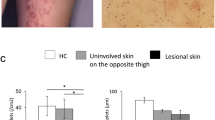Abstract
Little attention has been given to the involvement of sweat glands/ducts in the pathogenesis of prurigo nodularis (PN). According to recent studies, PN is likely to develop under conditions characterized by dry skin, such as atopic dermatitis (AD), suggesting a strong impact of skin dryness on PN development. No therapeutic modalities produced complete resolution of PN without exacerbations. We previously reported that increases in skin dryness by sweating disturbance could initiate the development of AD. We investigated whether sweating responses were impaired in refractory PN lesions; and, if so, we asked whether the PN lesions could resolve by restoring sweating disturbance. Using the impression mold technique, which allows an accurate quantification of individual sweat gland/duct activity, we examined basal sweating under quiescent conditions and inducible sweating responses to thermal stimulus in PN lesions and normal-appearing skin in the same patients before and after treatment with a moisturizer or topical corticosteroids. Sweating disturbance, either basal or inducible, was most profoundly detected in the “hub” structure corresponding to the center of PN papule before the treatment. This sweating disturbance was immunohistochemically associated with the leakage of sweat into the dermis. This disturbance was restored by treatment with a moisturizer. Our limitations include a relatively small patient cohort and lack of blinding. Sweating disturbance could be one of the aggravating factors of PN development. Refractory PN with low skin hydration may resolve by restoring sweating disturbance.




Similar content being viewed by others
Abbreviations
- AD:
-
Atopic dermatitis
- DCD:
-
Dermcidin
- HC:
-
Healthy controls
- IMT:
-
Impression mold technique
- LA:
-
Lichen amyloidosis
- LP:
-
Lichen planus
- PN:
-
Prurigo nodularis
References
Jorizzo JL, Gatti S, Smith EB (1981) Prurigo: a clinical review. J Am Acad Dermatol 4(6):723–728
Kitagaki H, Hiyama H, Kitazawa T, Shiohara T (2014) Psychological stress with long-standing allergic dermatitis causes psychodermatological conditions in mice. J Invest Dermatol 134(6):1561–1569. https://doi.org/10.1038/jid.2014.31
Lee MR, Shumack S (2005) Prurigo nodularis: a review. Australas J Dermatol 46(4):211–18–quiz219–20. https://doi.org/10.1111/j.1440-0960.2005.00187.x
Lee SE, Choi Y, Kim S-E et al (2013) Differential effects of topical corticosteroid and calcineurin inhibitor on the epidermal tight junction. Exp Dermatol 22:59–61
Mizukawa Y, Yamazaki Y, Shiohara T (2019) Leakage of sweat into the dermo-epidermal junction as a possible trigger for lichen planus lesion development. Arch Dermatol Res 311(1):71–82
Paus R, Schmelz M, Bíró T, Steinhoff M (2006) Frontiers in pruritus research: scratching the brain for more effective itch therapy. J Clin Invest 116(5):1174–1186. https://doi.org/10.1172/JCI28553
Rowland Payne CM, Wilkinson JD, McKee PH, Jurecka W, Black MM (1985) Nodular prurigo–a clinicopathological study of 46 patients. Br J Dermatol 113(4):431–439
Saco M, Cohen G (2015) Prurigo nodularis: picking the right treatment. J Fam Pract 64(4):221–226
Schmelz M (2010) Itch and pain. Neurosci Biobehav Rev 34(2):171–176. https://doi.org/10.1016/j.neubiorev.2008.12.004
Shimoda Y, Sato Y, Hayashida Y et al (2017) Lichen amyloidosis as a sweat gland/duct-related disorder: resolution associated with restoration of sweating disturbance. Br J Dermatol 176(5):1308–1315. https://doi.org/10.1111/bjd.15060
Shimoda-Komatsu Y, Sato Y, Yamazaki Y, Takahashi R, Shiohara T (2018) A novel method to assess the potential role of sweating abnormalities in the pathogenesis of atopic dermatitis. Exp Dermatol 27(4):386–392. https://doi.org/10.1111/exd.13448
Shiohara T, Sato Y, Komatsu Y, Ushigome Y, Mizukawa Y (2016) Sweat as an efficient natural moisturizer. Curr Probl Dermatol 51:30–41. https://doi.org/10.1159/000446756
Tanaka M, Aiba S, Matsumura N, Aoyama H, Tagami H (1995) Prurigo nodularis consists of two distinct forms: early-onset atopic and late-onset non-atopic. Dermatology 190(4):269–276
Tey HL, Yosipovitch G (2011) Targeted treatment of pruritus: a look into the future. Br J Dermatol 165(1):5–17. https://doi.org/10.1111/j.1365-2133.2011.10217.x
Yamaga K, Murota H, Tamura A et al (2018) Claudin-3 loss causes leakage of sweat from the sweat gland to contribute to the pathogenesis of atopic dermatitis. J Invest Dermatol 138(6):1279–1287
Funding
This work was supported by a grant from the Ministry of Education, Culture, Sports, Science and Technology (17K10220).
Author information
Authors and Affiliations
Contributions
All authors (CK, YH, SS, TS and YA) have read and approved the final manuscript.
Corresponding author
Ethics declarations
Conflict of interest
The authors declare that they have no conflict of interest.
Ethical approval
The study was approved by the Institutional Review Board at Kawasaki Medical University and followed the guidelines for the ethical conduct of human research (2238-4).
Additional information
Publisher's Note
Springer Nature remains neutral with regard to jurisdictional claims in published maps and institutional affiliations.
Rights and permissions
About this article
Cite this article
Katayama, C., Hayashida, Y., Sugiyama, S. et al. Prurigo nodularis as a sweat gland/duct-related disorder: resolution associated with restoration of sweating disturbance. Arch Dermatol Res 311, 555–562 (2019). https://doi.org/10.1007/s00403-019-01937-6
Received:
Revised:
Accepted:
Published:
Issue Date:
DOI: https://doi.org/10.1007/s00403-019-01937-6




